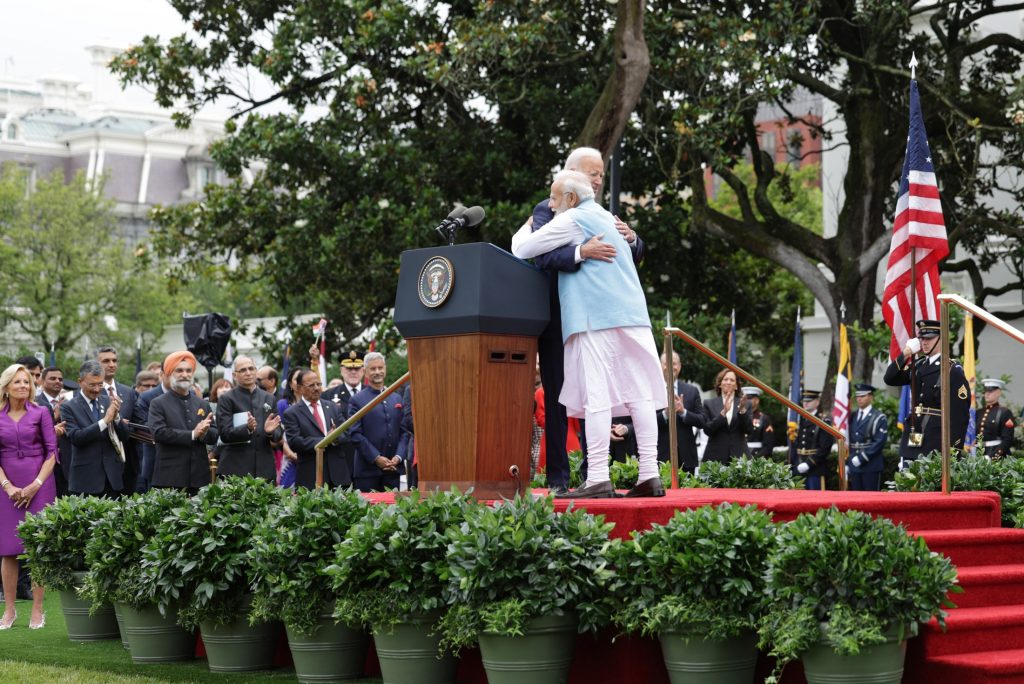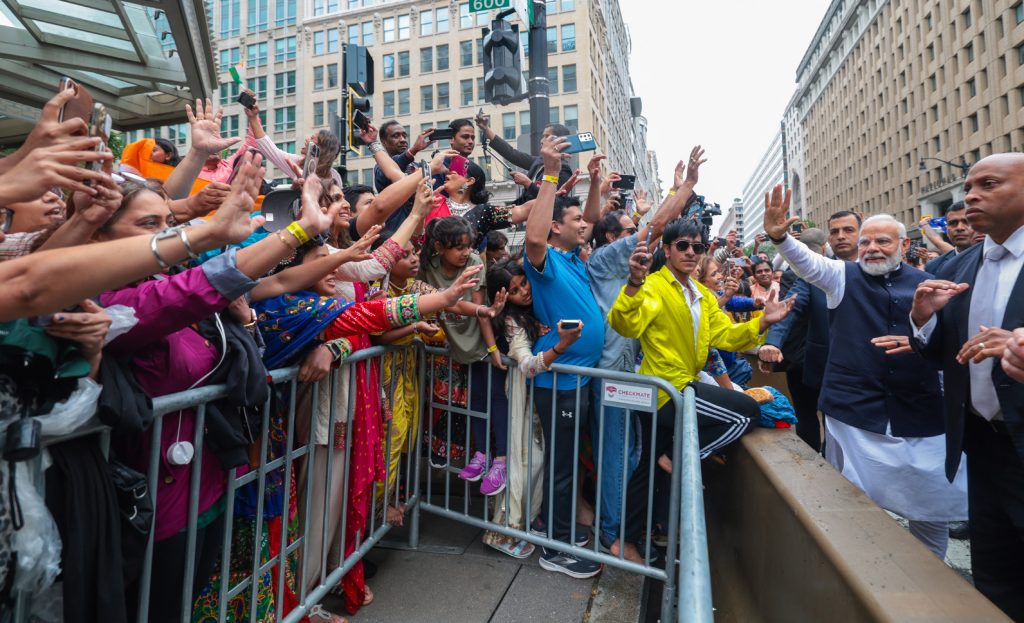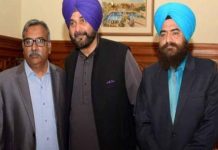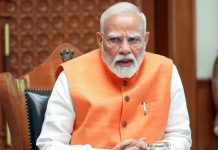
Modi-Biden summit has scripted a new chapter in the relationship between the two countries, which, perhaps, will have worldwide impact on the geo-politics. But the meeting between the two leaders has fallen short of forging any formal security alliance, writes Gopal Misra
It was a rare blending of the statecraft with the stagecraft, mastered by the two leaders, US President Joe Biden and his official guest, Indian PM Narendra Modi. They scripted a new chapter in the relationship of their countries, which, perhaps, will have worldwide impact on the geo-politics.
Modi’s three-day action packed programme between June21-24 could have out shadowed any blockbuster either in Bollywood or Hollywood with its meticulous details, each scene loaded with well thought out ideas and weighed that how much it would be impacting the audience across the continents, and indeed on the law makers at Capitol, where the Indian PM was the first chief executive of his country to address the Congress second time- a rare honour extended to a world leader. Thus, he joins the elite club of the leaders such as Nelson Mandela and Winston Churchill. Earlier, they had addressed this powerful bicameral legislature, Senate, the Upper House and the Lower House of Representatives, and on the chair were Vice-President Kamala Harris and Speaker Kevin McCarthy.

There were joint communiqué and other statements; but the most significant event, perhaps, was when Modi’s nearly hour-long address to the US Congress which evoked multiple standing ovations, applauses and cheers from American lawmakers. Amidst the thunderous applause and clapping, he received a rousing reception as he walked up to the podium to deliver his address. The grand House Chamber at the US Capitol also echoed with the chants of ‘Modi, Modi’ from members of the Indian community sitting there. Earlier, Modi had addressed a joint meeting of the US Congress for the first time in 2016, but it was different this time. During the past seven years, the two countries have successfully evolved common perception on many key issues influencing the earth.
Modi’s address before the Congess that “any hesitation in India-US relations belongs to the past, emphasizing that the two democracies are currently at a critical juncture and that he is visiting the country to speak about the “calling for the century.” It means that the present 21st. century is the era of progress and cooperation that the relationship between the two countries is being founded for the coming decades.
Rahul’s visit no spanner in works
Just two weeks before Modi’s official visit to the USA, Rahul Gandhi, de-facto chief of the Indian National Congress, the party which had ruled India most of years since the departure of the British in 1947, presented his anti-Modi campaign in a most amicable way. Being under the spell of his political Guru, Sam Pitroda, admired for the telecommunication revolution in India, he was more amicable and accessible this time. Pitroda claims that he hails from a family of carpenters, claiming to be having a tag of the backward community, from Gujarat was seen telling Rahul, his disciple or “chela” to be more caste-focussed and speak for Muslims. However, he never tells that his wife is from a high-caste Brahmin community. It is difficult to assess, whether Rahul’s visit adversely affected the outcome of Modi’s visit, but it definitely emboldened Indian American Muslims to enlist support of as many as 75 lawmakers at the Capitol as well as statement from the former US president Barrack Obama.

Obama’s statement, issued during the summit, that India might be further split, if the minority rights are not ensured. He, perhaps, was responding to the resolution of the two lawmakers Rashida Talib and Juan Vargas urging the State Department to act on the recommendations of the US Commission on International Religious Freedom (USCIRF) and designate India as a Country of Particular Concern (CPC) under the International Religious Freedom Act.
There was an intense campaign against Modi’s visit in New York, where posters were displayed on trucks asking “Hey Joe! Ask Modi why student activist Umar Khalid has been imprisoned for over 1000 days without trial?” Another poster drew the attention towards the ‘Lynching of Muslims, Christians and Dalits have surged under Modi’s rule,” The BBC documentary “India: The Modi Question” and the denial of a U.S. visa to Chief Minister Narendra Modi were the highlights of the anti-Modi campaign.
In a bid to counter the anti-Modi campaign, President Joe Biden and his administration appeared to be in full gear in defending Indian democracy. Both Modi and the US administration successfully turned the anti-Modi campaign as a part of “anti-India conspiracy”. On his part, Modi also presented himself in the best of his humour, when a journalist of an American channel asked him at the joint press-conference he had shared with Biden, about the plight of “minorities’ and the shrinking of “human rights” in India, and she also stated in a satirical tone that it is hoped that Modi would also hold press-conferences in his own country.
Indeed, it was Achilles heel for Modi, as during the past nine years since he is holding the country’s most important office, he did not hold any press-meet in New Delhi.
Before embarking on his official visit to Washington, Modi had stated that the two countries enjoy ‘trust’, and he reiterated in his address before the Congress that the mutual trust between the two democracies will enable us to explore new frontiers in science and space. Figuratively speaking, both Biden and Modi are determined to take the US-India relationship to new heights, even beyond moon and the unexplored space. During the summit, India and the US have committed themselves to work together in the exploration of the space, including frequent human visits to the moon and mars, and even exploring other planets.
Burying the Past
The India-US ties were always warm, if not intimate, except during President Richard Nixon’s administration in1971, when he had deployed his country’s warship equipped with nuclear devices in the Bay of Bengal to brow-beat India in support of the military rulers of Pakistan committing genocide of Muslims of the then East Pakistan, and the present Bangladesh. The White House archival details, now available in public domain, reveal that Nixon and his National Security Adviser (NSA), were not only abusive to the then Indian PM, Indira Gandhi, they also found themselves isolated within the adminsitraiton, when the American diplomats and media had rallied around opposing Nixon’s policies, which were favouring the genocide of Bengali Muslims in East Pakistan. During this period, Nixon had even asked China to invade India and warned USSR to face “consequences” if India is not restrained in supporting the uprising of Muslims in East Pakistan.
Even before Independence, the seeds of closer ties between the two countries were sown during the presidency of Roosevelt, who had been a consistent supporter of India’s independence and had even advised the then British leader and the war-time PM, Winston Churchill against India’s partition, but the British divided India on communal lines before leaving the country.
A Successful Visit
Modi’s three-day official visit to Washington is considered much more important than the earlier visits of his predecessors, Pandit Jawaharlal Nehru, P.V. Narsimha Rao, Atal Bihari Vajpayee and Dr. Manmohan Singh. During fifties and sixties, India-US relations could not blossom despite Nehru’s official visit to the USA. It was the period of cold war between the US-led western powers and the USSR’s Communist camp, and Nehru’s much-trumpeted non-aligned foreign policy was not acceptable to the Americans. They had continued to arm Pakistan with the state-of-the art weapons, which were later used against India. However, the relationship between the two countries started improving following the visit of P.V. Narsimha Rao to Washington, who had laid the foundation of opening of the Indian economy. It was the beginning of new India-US ties, which was continued during the regimes of Vajpayee and Dr. Singh.
It was the period, when the world witnessed a paradigm change in the world politics following the collapse of the USSR, and the emergence of the USA as the only Super Power on the earth. Three decades later, during the third decade of the 21st. century, China has emerged as a serious contender to replace America as a Super Power.
Blossoming of India-US Ties
Modi’s visit is just not limited to a security understanding or obtaining new generation weapon systems, but it paves the way for the blossoming of Indian genius with the American resources for better world order. In his address to the Congress, Modi told the law-makers that India has a huge pool of well-trained engineers and scientists, who could be contributing to the US-India joint ventures with their hard work blended with talent.
Earlier, Biden’s predecessors used to harbor ‘suspicion against Nehru’s non-aligned policies, but in contemporary America, the political leadership across the party lines consider the economic empowerment of the Global South is the only solution to contain China’s growing penetration across the continents.
Modi’s American visit has taken place, when Indian geniuses are transforming the country’s economy by blending knowledge with financial resources. In recent years, India has already achieved third position among the successful 108 unicorns. It may be noted that the new start-ups having a USD one billion investments are called unicorn. The Indians comprise a little more than the one third of the work force in the Silicon Valley, India is already technically advanced to receive and further develop technologies received from the USA. Therefore, the visit is being aptly described that “Modi’s time has come, when India’s time has also come”.
For many, it was a three-day show or “tamasha” of blending glamour and excitement from New York to Washington for Modi as well as for Biden, as both are going to face elections in 2024. Biden would be re-contesting for his second innings in the White House and Modi for his third –term.
Apart from joining the Yoga Day at the UN with famous film stars and celebrities, Modi met the scientists and investors, thus laying the foundation of a long-term multi-lateral cooperation with US academia, business and joint ventures in the frontier of science and technology.
US-India ties on the upswing
During the first quarter of the 21st. century, the successive US administrations, especially during the presidency of George W. Bush (2001-2009) and Barack Obama (2009-2017), have been accommodating to India’s core national interests and acknowledged outstanding concerns. During this period, there was a phenomenal increase in bilateral trade and investment, co-operation on global security issues. Before Modi’s official visit in 2023, the USA had been supporting India for admission to the Nuclear Suppliers Group and started joint-manufacturing through technology sharing arrangements. India was declared a Major US Defense Partner.
Both Biden and Modi are aspiring for yet another term for them in their respective high offices in the 2024 elections, when American would be electing a new President and In India, the Lok Sabha polls would be deciding the future of Modi and the ruling BJP.
There could be many reasons, which have finally led to the signing of ‘Critical Partnership’ in key areas, the first, that the Indian scientists and engineers have attained worldwide fame for their excellent performance in the frontiers of science research and technologies. It is often stated in America that it is easier to get admission to MIT, Harvard or any other Ivy League schools, viewed as some of the most prestigious universities in the world, than seeking admission to an IIT in India; secondly, Indians, who are trusted for their professional integrity occupy top positions in the American companies and universities, thirdly, India’s multi-party democracy has brought a stable system of governance for 140 billion people. The fourth reason, which is not being talked about is that despite grave provocations, India has been facing China with her own resources and defence capabilities.
Another reason which could have prompted the American establishment to have closer ties with India is that there are only two countries in Asia, India and Vietnam, who refused to be over-awed by the PLA. In February 1979, Vietnam had successfully repulsed the Chinese forces. One month later in March, China unilaterally withdrew its army. Earlier, during September 11-15, 1967 during the clashes at the Nathu La in Sikkim, Chinese casualties were estimated at 300 soldiers, while India had lost only 32 soldiers. The two countries do not subscribe to the much-trumpeted ‘invincibility’ of the Red Army.
Meanwhile interestingly, just 48 hours before Modi’s official visit to the US, the American Secretary of State Antony Blinken rushes to Beijing on June 19 ,where the Chinese President Xi Jinping welcomes the top U.S. diplomat at the Great Hall of the People, a grand venue usually reserved for greeting heads of state, and observed “progress” after shaking hands with his American guest.
Some key takeaways from PM visit
The US has decided to draw a bilateral roadmap for the next level of interoperability by sharing some critical and emerging technologies with India. The initiative signed on Critical and Emerging Technology (iCET) between India’s Defence Minister Rajnath Singh and the US National Security Advisor Jake Sullivan has been furthered with INDUS-X during Modi’s visit. It will connect the national security innovation ecosystems of the two nations for research, development, and production of dual-use critical and emerging technologies.
Joint statement against terrorism
Biden and Modi not only condemn cross-border terrorism, they have also unveiled an extensive 58-point joint press statement , which commits for increasing trade and investment partnership as an “engine for global growth.” It envisages establishment of the interagency-led Strategic Trade Dialogue to explore avenues for enhancing high technology commerce and facilitating transfer of technology, which included the signing of a Memorandum of Understanding on Semiconductor Supply Chain and Innovation Partnership. They have also decided to launch of two Joint Task Forces on advanced telecommunications, with a specific focus on research and development of technologies like Open RAN and 5G/6G and the joint Indo-U.S. Quantum Coordination Mechanism, which aims to foster collaboration among industry, academia, and government. These agreements also included the collaboration between General Electric and Hindustan Aeronautics Limited for manufacturing of GE F-414 jet engines in India.
…………..
Ukraine no hurdle
The USA did not ask India to condemn Russia for the Ukraine war, but in the joint statement, both leaders expressed deep concern over the ongoing conflict in Ukraine and mourned the humanitarian loss and emphasized the need for a peaceful resolution.
More muscle for Quad
Both Biden and Modi have decided for further strengthen the Quad as a partnership for global good. They emphasized the significance of a “rules-based international order. In West Asia, they decided to further the partnership between the I2U2 countries (India, Israel, United Arab Emirates and the United States).












